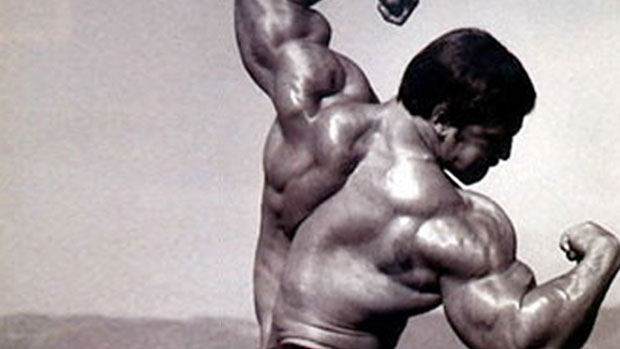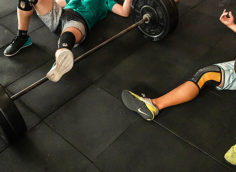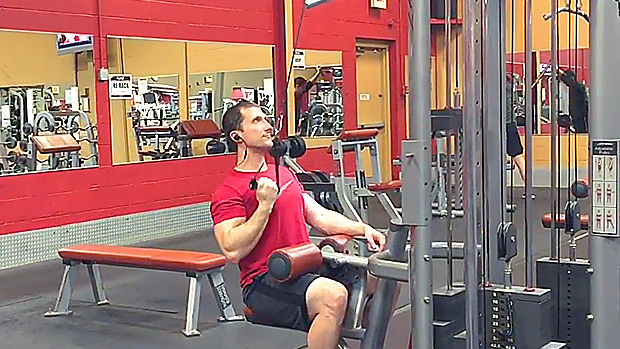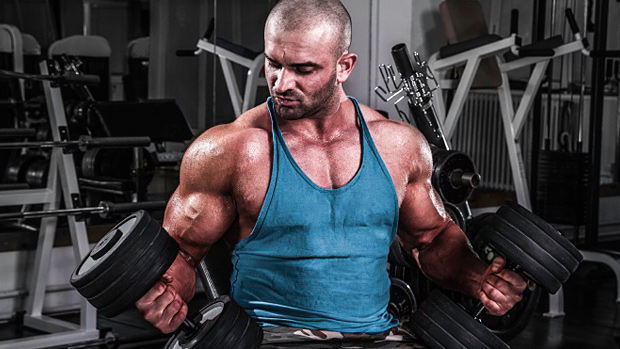As a kid growing up, I loved to hear Jim McKay start every Saturday's broadcast of Wide World of Sports with these memorable words: "Spanning the globe to bring you the constant variety of sport. The thrill of victory, and the agony of defeat. The human drama of athletic competition. This is ABC's Wide World of Sports!"
After 2008, with the Olympics and the election, I suspect we've all had enough of the human drama, in or out of competition. But what the late, great Jim McKay inspired me to do was span the gyms of the world to find the constant variety of training information.
Here are just a few.
The Texas Experiment
I'm not a big HIT fan, but I've always been fascinated by the Colorado Experiment , in which Casey Viator allegedly gained 63 pounds of muscle in 28 days, while doing just 14 workouts that averaged 34 minutes. (Arthur Jones, conductor of the Experiment, modestly calculated that Viator gained eight pounds for each hour of training.)
I'm also not a big fan of training arms, mainly because I'm too tired after squatting, benching, deadlifting, and having a life. I'm sure there'll be lots of time for curls and delt raises when I'm done powerlifting.
Recently, however, I got a wild and random idea to try some arm training. I guess I was inspired by Casey and the ghost of Arthur Jones to see how much I could accomplish with an absolute minimum investment of time.
I added one set of drag curls to each of my twice-weekly bench workouts. To keep it simple, I kept the bar weight the same throughout the experiment, and added one rep in each of 11 workouts, which took seven weeks.
When I started, I chose 95 pounds as the weight, figuring I could do 11 or 12 reps with it. I started out at eight reps. I didn't come close to failure until the last two workouts.
Results: I gained three-quarters of an inch on my left arm, and almost that much on my right. That brought both arms up to almost exactly 18 inches. I actually lost a few pounds of body weight during the experiment, and my arms increased in size despite the fact I drastically lowered my volume of upper-back training because of a lat injury.
While it's nothing to alert the muscle mags about, the results confirmed my faith in two simple adjectives that describe any training program that produces muscle hypertrophy: different and progressive.
"Different" means something you aren't doing right now. If you've been using high-volume workouts, try HIT. If you've been using higher weights and training close to failure, try a volume-based approach. If you train arms at the end of the workout, do them first.
I don't think rep cadence is crucially important for hypertrophy (although it's useful for other reasons, as I explain later in this article), but if you've been heaving, exploding, or bouncing your reps, try going for slower, more controlled reps, and vice versa.
"Progressive" means increasing either in volume or intensity, or reducing time between sets. Just don't try to do them all at once. Freeze two variables, and change the third.
Keep it simple.
The Todd Effect
A few years ago, I read an article by Terry Todd in which he described training his wife, Jan, to be the first woman to squat 500 pounds in a meet. She accomplished this in 1981.
His first goal was to figure out her weaknesses, using a memorably unique approach. He had her do multiple low-rep sets of just one basic exercise — in her case, the squat. Then over the next few days he had her describe where she felt sore.
I'm not nominating soreness as the best indicator of anything and everything, but I think I can say this with some certainty: If three different athletes did this same experiment, using the same exercise, they'd all be sore in different places. Soreness is as good as anything else to show you where to focus your assistance training.
I tried it on myself recently, using the deadlift with 50 percent of my one-rep max, doing five or fewer reps per set, with a minute of rest in between. I ended up doing 25 sets with a total of 108 reps.
While my hamstrings were slightly sore in the next few days, the left was much worse than the right, and my glutes were actually even worse. I had no soreness at all in my lower back or quads, but my lats and rhomboids were fried. My traps? Nothing.
The soreness confirmed my suspicion that my glutes weren't firing correctly most of the time, while my left leg was doing a lot of the work for the right leg. I'd been doing less upper-back training recently, and the soreness confirmed that it's time to get back to work there.
Is this a potentially dangerous way to discover muscle imbalances? I don't think so; using just 50 percent of your 1RM makes it a low-risk way to achieve a real benefit.
The alternative is to hire a trainer to do an analysis of your movements, and hope he knows what he's doing. If you live near Eric Cressey or Mike Robertson, that's an easy call. If not, you could be taking a very expensive crapshoot.
What I like about the Todd approach is the fact it's self-customizing. It'll reveal your specific weaknesses.
You can also use it, with a few tweaks, as a conditioning method.
Ethan Reeve, the head strength and conditioning coach at Wake Forest, has his football players do a drill called "Game Day" at the end of summer conditioning. Every minute for 50 minutes, the players do one or two power cleans. Some athletes use more than 300 pounds for all 50 sets.
I'm no fan of Olympic lifting, unless you're preparing to be an Olympic lifter, but being able to do 50 to 100 reps of power cleans with 200 to 300 pounds is a pretty good sign that you're ready to play football for 60 minutes.
I would argue that it's maybe a tad better than a two-mile run, which many coaches seem to love.
You can do your own Game Day with any complex exercise — squats, cleans, deads, trap-bar deads, or even a pressing movement.

Try 50 to 100 reps and see what happens.
Hurting the One You Love
Who does an athlete love most? Himself. Who's most likely to cause an athletic injury? The athlete.
Most of our injuries are our own fault. We don't give our bodies a break when we know we need one, or we ignore imbalances that need to be addressed. That's how we end up hurting ourselves, usually with muscle pulls or tears.
Unfortunately, we make it worse by punishing ourselves, doing the opposite of what would facilitate a full recovery.
I'm pretty sure most of you know about RICE, the four-part protocol for treating an acute injury: rest, ice, compression, elevation. But how many of us actually use it when it counts?
Over the years I've gotten pretty good at immediate icing and compression if I tweak something, since I always have my cooler and knee wraps at meets. Elevation? Rarely happens.
And what about rest? I offer that rest is usually done all wrong. Taking a few days or weeks off to let an injured body part heal can often be the worst thing to do. Unless you have a bone sticking out, discoloration and bruising by the next day, or a great amount of pain, you should begin light mobilization of the injured area within two or three days.
Here I'll add the usual disclaimer: I'm not a doctor, I haven't played a doctor on TV, and I didn't stay in a Holiday Inn Express last night. When in doubt, consult a physician, yada yada yada.
To put it bluntly, however, most MDs I've seen post-injury were huge disappointments. Without an MRI (and believe me, you won't get one as expeditiously as your favorite NFL player), their guess of the extent of your injury is only slightly better than yours ... but a lot more expensive.
This is a good time to describe the difference between pain and discomfort. Pain hurts, it's sharp, and it stops you in your tracks. Discomfort is unpleasant, but it can be worked through.
Let's say you tear a pec completely. Pain? Oh yes. You won't be able to do anything but wait two or three weeks for the MRI to tell the doctor what you and your training partners already know: it needs surgery.
But let's say it's just a slight tear. You'll be able to do floor presses with dumbbells or an unloaded bar within two or three days. I rarely consider tempo at all except when I'm trying to move the bar faster, but when you're mobilizing an injured muscle, you want a slow and smooth rep cadence. Do sets of 20 or more reps. You'll speed up the healing process by improving blood flow and breaking up adhesions, or avoiding them altogether.
Stretching and massage are also important, but motion is your first priority. Stay within your comfortable range of motion at first. Then, in subsequent weeks, improve your range with the help of increasingly aggressive stretching and massage.
From experience, I've found the following movements work best for mobilization:
• Walking is good for anything that hurts. We were built to walk, not bench press 700 pounds, throw 95 mph fastballs, or tackle 220-pound running backs.
• Upper-body push injury: dumbbell or barbell floor press.
• Upper-body pull injury: dumbbell one-arm row.
• Lower-body push or pull injury: box squat, goblet squat, good morning.
In summary:
1. For any injury, RICE it immediately. Rest, ice, compression, and elevation. Don't delay.
2. Look for bruising and swelling the next day.
3. Figure out if the injury is causing pain or discomfort. Pain is sharp, searing, show-stopping, and perhaps even life-affecting. You probably need to see a doctor. Discomfort can be painful, but it's not so severe that you can't move or put weight on the injured area.
4. After two or three days of intermittent RICE, work on mobilizing the area, using the exercises listed above. Stay within the pain-free range of motion for one to three sets of at least 20 reps. Do this each day, adding more range of motion when you can. The goal isn't to find the point where you can make it hurt. It's to increase the range where it doesn't hurt.
When you get to a full, pain-free range of motion, start adding five to 10 pounds each workout. This not only gives you time to heal, it makes you humble.
You can also expect to experience psychological difficulties as you recover. If your self-worth is wrapped up in your identity as an athlete in your sport, this can be a tough time. And it helps explain why we so often hurt the ones we love most, which is to say ourselves.
Next time you're recovering from an injury, and you're tempted to get back to full-speed workouts before you're ready, ask yourself this question: Are you doing this for your mental comfort, or because it's the best way to heal and get back to competition?
Hard question, but there's often an easy answer.
Clarity Begins at Home
I don't give much unsolicited advice in the gym anymore. A lot of folks don't listen, or they'll listen just to find something they can turn into an argument. If somebody asks me a question, I'm happy to take the time to answer or demonstrate something. Even then, though, things often get strange.
But nothing is as strange as the moments when people give me unsolicited advice.
Just a few weeks ago, an old guy came over to admonish me about deadlifting with no belt. I listened attentively, and agreed that using a belt was a good idea in many circumstances. When asked if I wanted to end in a wheelchair, I said no, I didn't want that.
Then I explained why I prefer to train my deadlift raw, and only use a belt and loose suit in meets. This just set him off more. I'll spare you the details, except to say it made me appreciate the well-reasoned (and sometimes less well-reasoned) emails I get after an article is published.
The gym in many ways has become a microcosm of our country and our political process. Lots of angry people jump at the chance to get into a shouting contest. I avoid that mess when I can, but at the same time I believe we have a duty as Americans to help our families, friends, and neighbors with their training issues.
What the American people want is an opportunity to gain some muscle while losing the fat they're saddled with.
Politicians have pursued pro baseball players who used performance-enhancing drugs, but ignored the corporate gyms that preyed on the little guy, giving him nothing in return for his membership fees beyond empty workout plans developed by "personal trainers" with little fitness expertise but large incentives to sell their services to people who don't know any better.
Those of us who've improved our proportions during the past few years owe it to our families, friends, and neighbors to give them a chance to achieve the American dream of a fit body and healthy diet.
Just a few months ago, I was travelling in Florida and met with my brother. He has one leg smaller than the other, thanks to a freak hiking accident. We set aside our differences, along with our beers and steaks, and tackled some of his problems with single-limb exercises like Bulgarian split squats. My brother is now doing plyometric jumps onto a 36-inch box.
As I've always said, the best way to give your fellow Americans a leg up is to show them how to do single-limb work, and get them doing plyos.
Our children, the future of America, have been exposed to too many training approaches that have not served them well. It's our time. We are the experts we've been waiting for.
If your child is a cross-country runner, don't let some coach force him to do power cleans, or double his training volume in a two-week span. If your children play baseball or softball, make sure they do rotator cuff work.
There is so much good we can do right in our own neighborhood and garage gyms. Let's make our training advice available to the hard-working Americans who can't afford to hire a trainer to work with them one-on-one.
Just the other night, a neighbor lamented to me that her personal trainer wasn't helping her. She told me she was working hard, but despite all the miles on the treadmill and recumbent bike he had her doing, along with the light weights she was lifting for high reps, she wasn't losing the weight or getting the definition in her triceps that she'd sought when she first hired him. Her diet, based on his recommendations, was high in carbs but low in fat, protein, and good sense.
This woman, who'd done nothing but work hard and play by the rules, simply didn't know that the way to reach her goals includes fewer carbs and more protein. She didn't know she should get her cardio by walking briskly in the neighborhood. She didn't know the gym is best used for lifting heavier weights, which won't make her bulky because she's a woman.
Yes, we can give better advice to the people who need it most.





